Arsenal Women hosted VfL Wolfsburg Women in the first leg of the UEFA Women’s Champions League quarterfinals, which ended in a 1-1 draw, leaving the pressure on for their next meeting in Germany.
Wolfsburg scored an opener early on, thanks to Tabea Waßmuth’s strong positioning and constant aim to threaten the goal. Arsenal met quite a lot of resistance and their inefficiency in attack was about to cost them the three points, but they managed to convert a late set-piece opportunity into a goal and equalise in the 89th minute.
Despite being more efficient in and out of possession and creating quite a few chances, Arsenal lacked the finishing to really test Almuth Schult and take advantage of their chances. Wolfsburg relied on breaking through the right flank in attack but also tried to create some chances on a counter, which increased the threat in front of the opposition’s goal. However, the Londoners’ pressing efforts turned out enough to limit Wolfsburg’s movement and keep them away from scoring again.
In this tactical analysis, we examine both teams’ tactics in the game and explain how they managed to expose each other.
Lineups and formations
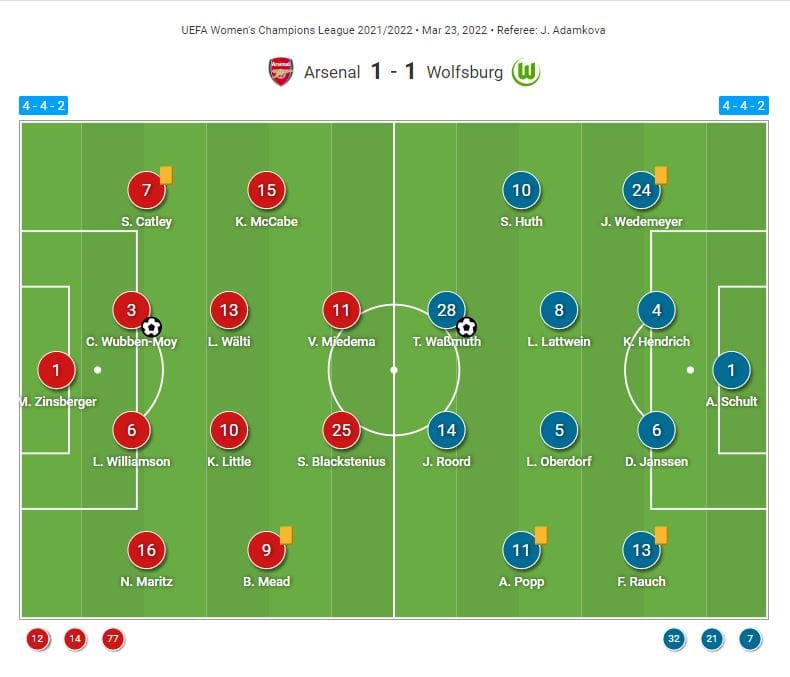
Jonas Eidevall, Arsenal’s head coach, opted for a 4-4-2 formation, which he rarely goes for, being drawn more towards the 4-3-3 and 4-2-3-1.
Manuela Zinsberger covered the goal and the defence consisted of Stephanie Catley, Lotte Wubben-Moy, Leah Williamson and Noelle Maritz. Wubben-Moy ended up as the only goalscorer for the team in the game, while both full-backs were constantly pushing forward and supporting the actions in the opposition half.
In central midfield, Eidevall relied on Lia Wälti, who had a more defence-oriented role and Kim Little who was responsible for orchestrating the play through her passing. Katie McCabe and Bethany Mead covered the left and the right flank respectively, while Vivianne Miedema and Stina Blackstenius troubled Wolfsburg’s defence centrally.
Tommy Stroot set Wolfsburg up in a similar 4-4-2 with Almuth Schult on the goalkeeping position and Felicitas Rauch, Dominique Janssen, Kathrin Hendrich and Joelle Wedemeyer in defence. For the most part, Rauch was pinned back and didn’t go out high too often, while Wedemeyer constantly strolled up and down the right flank.
Lena Lattwein and Lena Oberdorf were the central midfielders, flanged by Alexandra Popp and Svenja Huth. Jill Roord and Tabea Waßmuthwere lined up in attack. Lattwein’s defensive contribution was crucial and provided more security on multiple occasions.
Arsenal’s pressing strategy aiming dominance
Arsenal put a lot of effort into executing their pressing strategy, aiming to control the game and limit Wolfsburg’s movement in possession. The team tried to maintain a high press intensity throughout the game in an effort to block the opposition build-up and recover the ball as quickly as possible. The Londoners averaged a PPDA of 6.61 which resulted in recovering the ball in the opposition half rather often. Although most of their successful efforts were in midfield, 19 of their recoveries were executed in the final third.
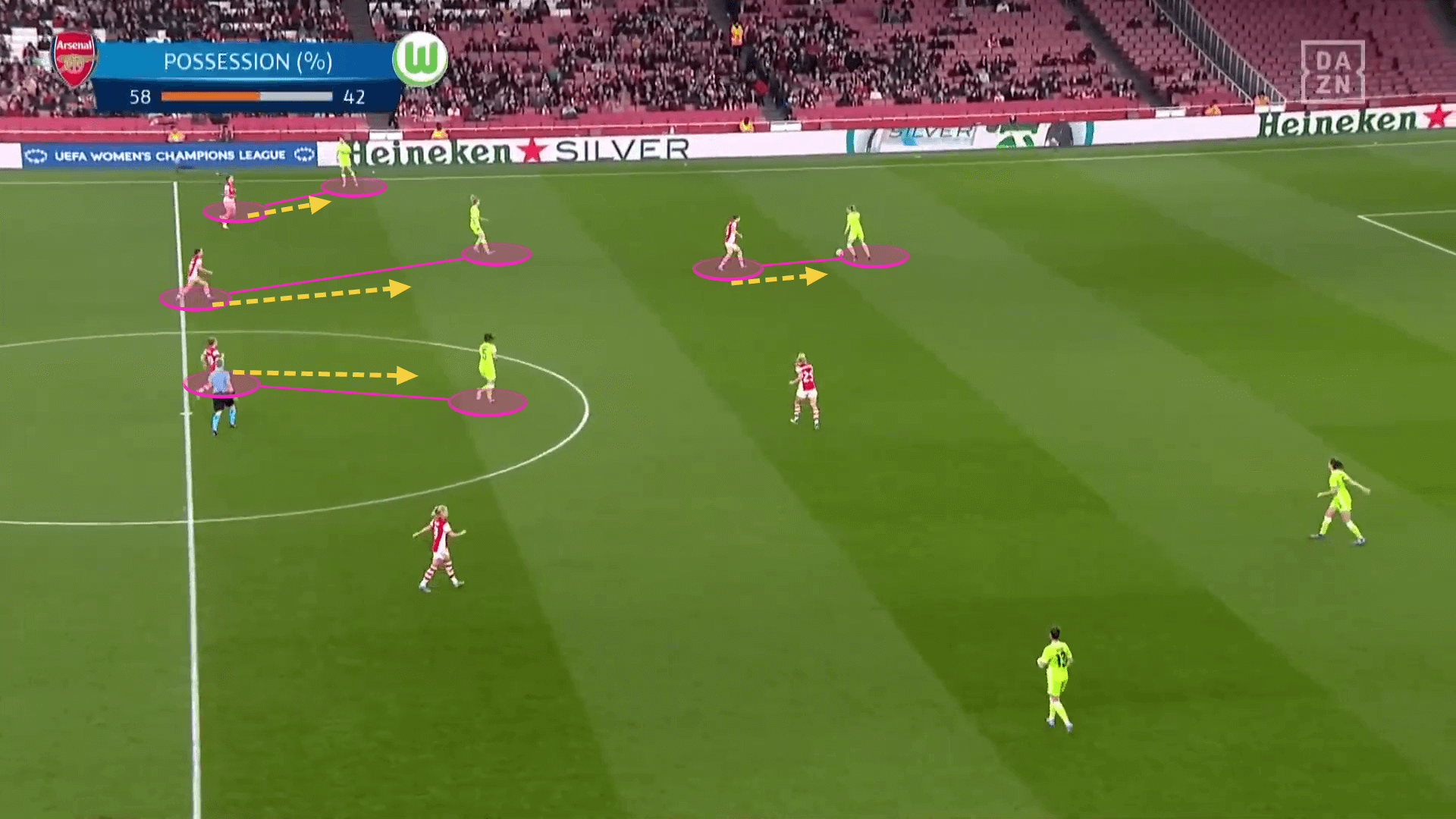
The two centre midfielders Wälti and Little were crucial for gaining back possession and stopping Wolfsburg’s attacks midway, although the left-sided players in the face of Catley and McCabe and later on Tobin Heath were also very active in their efforts to stop their opponents’ attacks through the wide areas.
Their press respectively affected their time on the ball. Arsenal dominated possession throughout the whole game with an average of 59.68%, which often forced the German team to seek other ways to create opportunities. That’s why they tried to expose the opposition on a counter, which increased their chances as all of their three counter-attacks ended with shots.
The whole Arsenal team constantly pushed forward and were in a more advanced position, which helped them in their ball recovery efforts as they could counter-press immediately after they lose the ball. Their advanced position, though, had its flaws too, as it allowed Wolfsburg to expose them at the back due to the defenders’ advanced position. As per usual, they wouldn’t drop deeper and focus on defending but were very active in ball retention and progression. The two centre-backs would move closer to the central line, while the full-backs would be past it, in efforts to efficiently build up from the back and overload the opposition half with players.
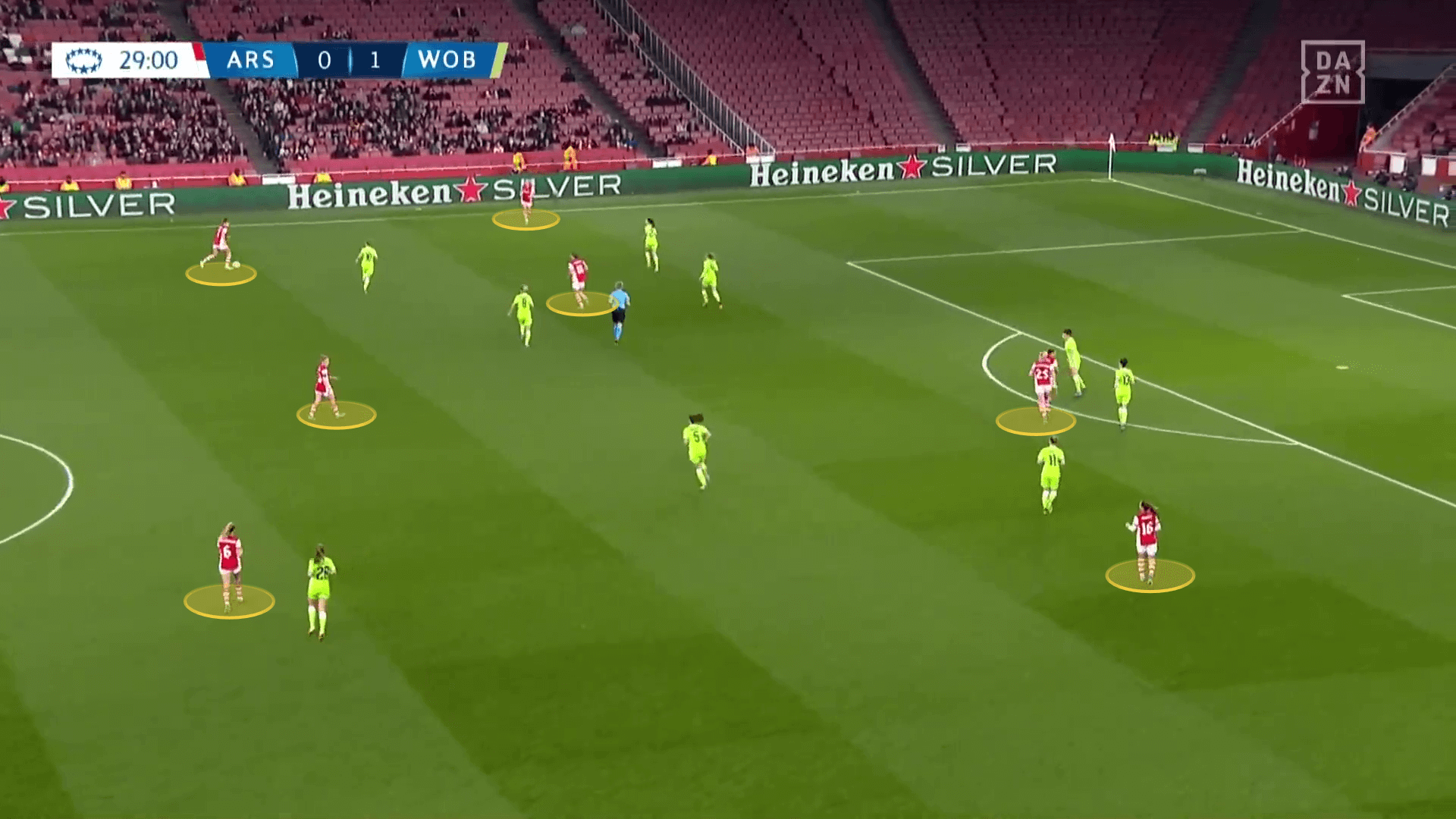
Wolfsburg’s attacking ventures and their defensive fragilities
As explained above, Wolfsburg were often pinned back, which resulted in having difficulties with their build-up-play and ball progression. Arsenal’s successful pressing efforts forced the team to move into a deeper position and the head coach instructed the attacking players to drop closer to the central line to provide passing options and support ball progression.
This resulted in the goalkeeper Schult being heavily involved in ball retention as the defenders would constantly send the ball back to her. Her contribution is also underlined by the team’s most frequent passing links, which shows that Schult and Janssen exchanged the ball 20 times.
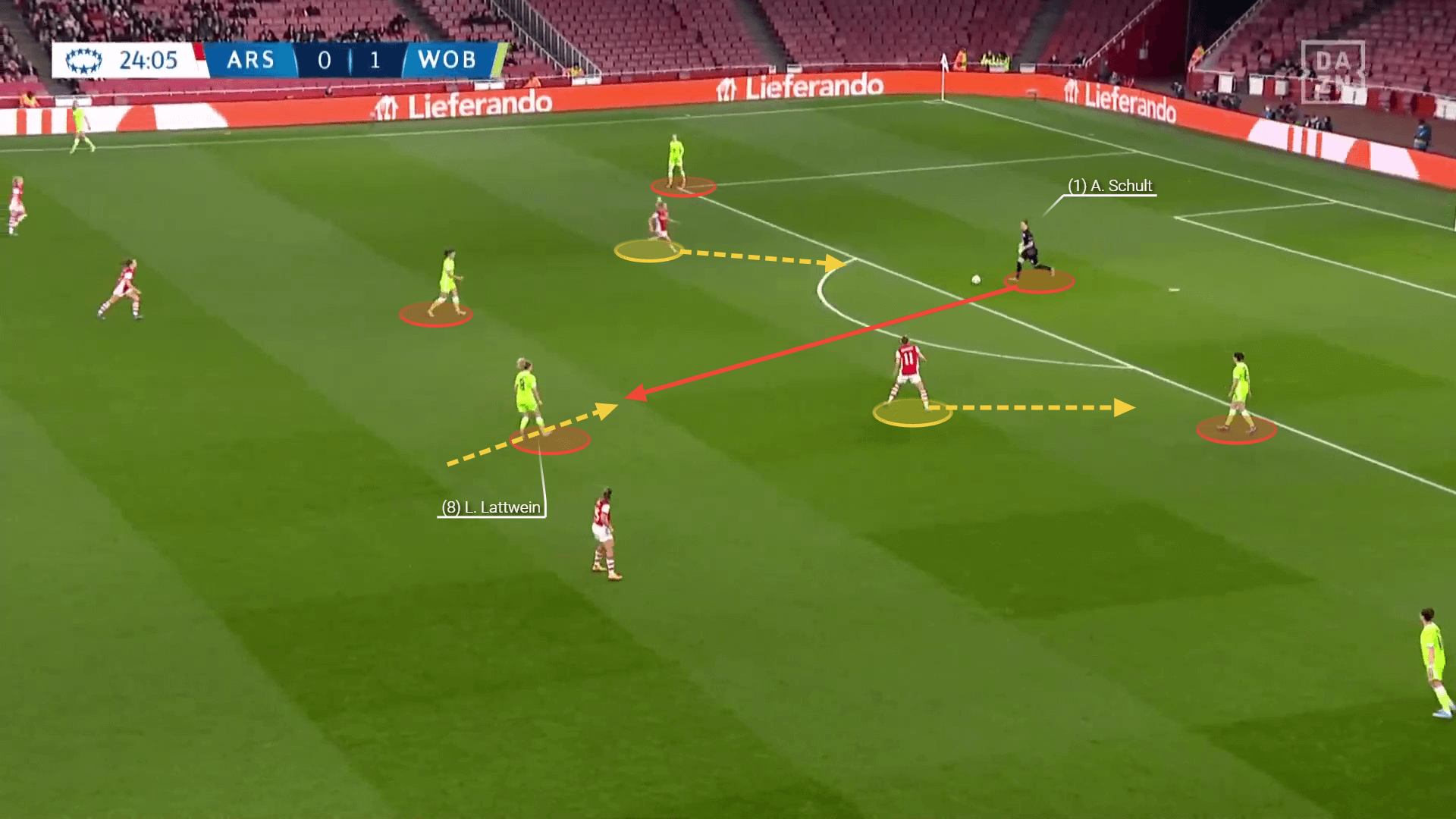
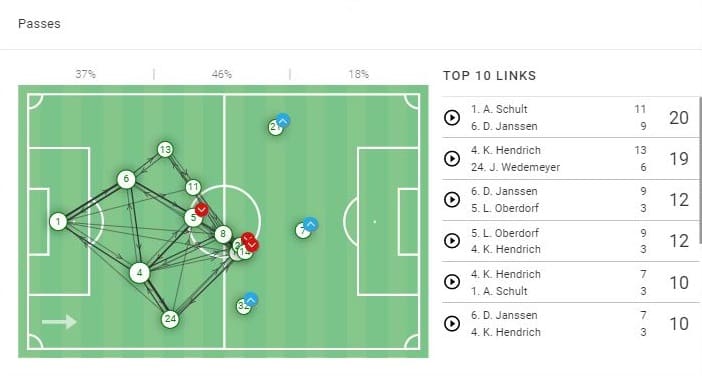
Oberdorf was also key for releasing the pressure as she would act as a passing outlet and try to open the passing lanes by offering chances for one-touch combinations with the defenders.
The overload Wolfsburg created in the central areas, with the attackers dropping back, provided Joelle Wedemeyer with a bit more freedom on the right, which she used quite efficiently to expose the opposition. Although she didn’t win many of her offensive duels (3/10), she was crucial for ball progression, especially through her long balls and thanks to the combinations she would do with her teammates. Her efforts resulted in providing an assist for Waßmuth’s goal.
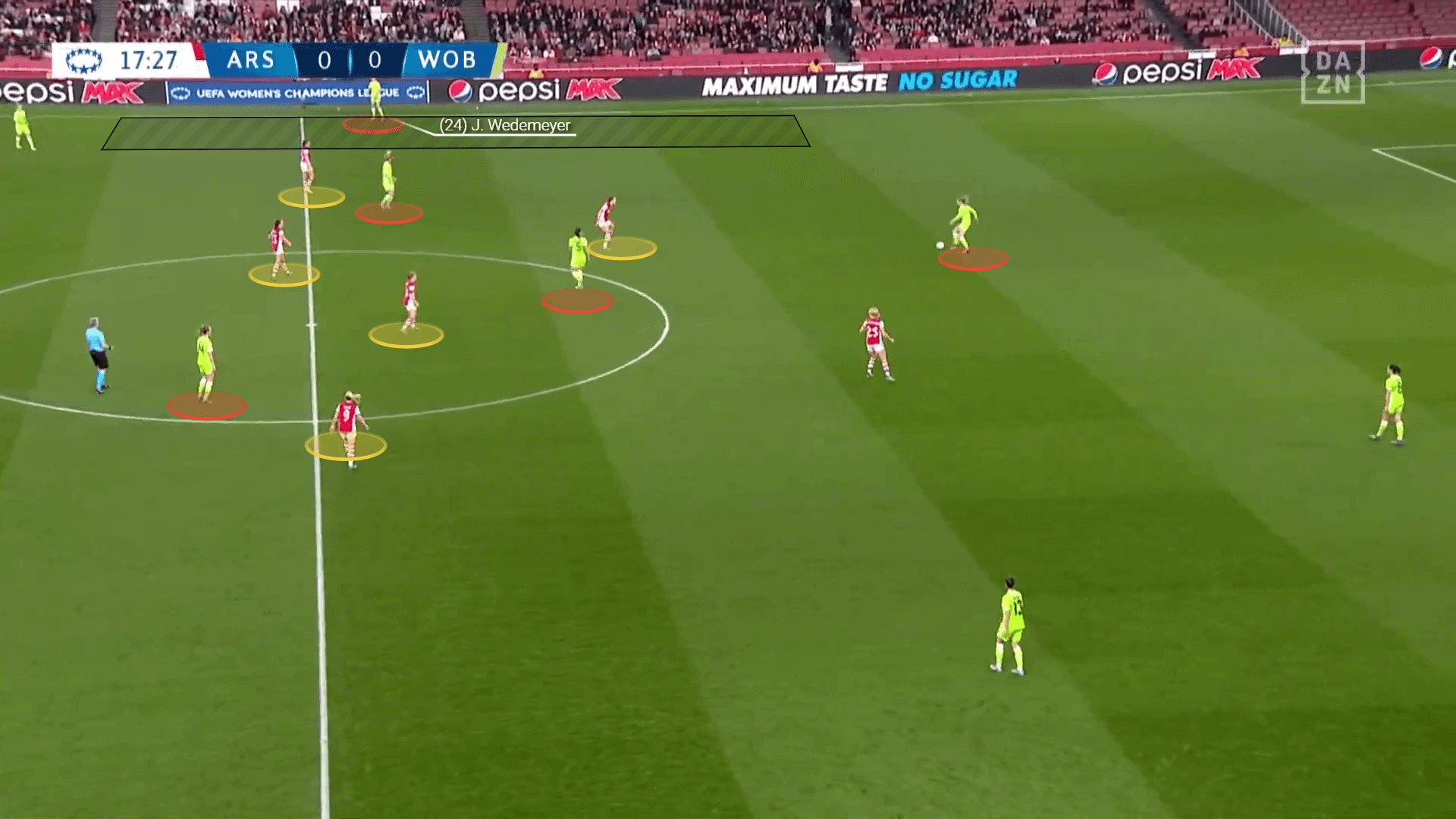
The team, though, weren’t very efficient in their passing and their inaccurate actions often stopped their attacks from unfolding. Their low pass completion rate also cost them quite a few defensive struggles.
Arsenal would also try to expose their opponents through the flanks, but their approach was more balanced as they didn’t overcommit to one area. That would cause havoc in Wolfsburg’s defence and they would often get out of position in an effort to cover the ball carrier allowing Arsenal space to combine. Despite her contribution in possession, Wedemeyer was the reason for Arsenal’s lower efficiency on the left, as her defensive positioning was strong and she would win her direct challenges and help the team to recover the ball.
Conclusion
Arsenal increased their chances for a first Champions League semi-final since 2013 with their equaliser, although, as our analysis showed, Wolfsburg’s resistance might make the task will be difficult to achieve. The team need to throw a lot of effort into their upcoming FAWSL meeting with Tottenham Hotspur which might take a toll on their preparations for the CL.
The Bundesliga leaders will be inspired to get the win in Germany and repeat their success against Arsenal, who they kicked out of the competition in 2012/13.





Comments